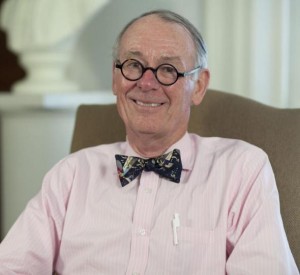Jefferson in England
By: Richard Guy Wilson, Commonwealth Professor and Chair, Department of Architectural History
Thomas Jefferson visited England three times: July 25-31, 1784, March 11-April 28 1786, and October 8-22, 1789. In addition to this first-hand knowledge, his large architectural library contained a substantial number of English architectural books. A book that Jefferson greatly valued, The Architecture of A. Palladio, was actually an English language edition that contained numerous differences from the original Italian publication. Much of Jefferson’s knowledge of Italian architecture came through an English lens.

Jefferson’s time in England—especially the 1786 trip which consisted of a several week tour of gardens with John Adams– has been noted but never analyzed at length as to what he saw beyond a description of the gardens. After Jefferson returned to the United States in 1789 he maintained close ties with English trained designers including Benjamin Henry Latrobe. Scholars have suggested that Jefferson’s design for the University of Virginia was influenced by the layout of Cambridge’s Downing College, though again, this is usually noted but not treated in any depth. Jefferson visited Oxford but never Cambridge. Since the Wilkin’s design for Downing dates to c. 1804, how Jefferson might have known it remains a question that needs to be answered. Oxford did play an important role in his experience, especially the colleges and also the botanircal garden.
In a letter Jefferson wrote to a correspondent he claimed:
“London, tho’ handsomer than Paris, is not so handsome as Philadelphia. Their architecture is the most wretched stile I ever saw, not meaning to except American where it is bad, nor even Virginia where it is worse than any other part of America, which I have seen.” (Jefferson to John Page, May 4, 1786, Papers, 9:445-46).
This passage is frequently cited by historians as a reason to ignore the impact of English architecture on Jefferson. Another example of his lack of respect for English architecture is further reflected in his dismissal of Lord Burlington’s Chiswick which he visited: “The Octagonal dome has an ill effect,” (Jefferson “notes” c. April 1786, Wilson and Stanton). This criticism has been interpreted by some scholars to the effect that Chiswick exerted little impact on his later remodeling of Monticello.
 The usual approach to the influence of British design on Jefferson by most historians is relegated to the curving paths of Monticello’s gardens as reflecting the English Picturesque. Another area noted by some scholars involves his employment of busts of important figures in the entrance hall at Monticello which might have a source in StoweGarden. However, no attention has been paid to the various pavilion fronts at the University of Virginia, Jefferson’s court house designs, and several houses by Jefferson such as Barboursville, as having possible English influences. The Virginia State Capitol, which is perhaps the most political of Jefferson’s buildings, was designed in conjunction with a French architect, Charles-Louis Clérisseau and modeled on the Maison Carree (a Roman temple) in Nimes, France. However, there was an English element never noted by historians and that was that Jefferson knew the Maison Carree through the English Palladio volume. Jefferson’s drawings for the facades of the Virginia State Capitol come from the English volume and not French sources.
The usual approach to the influence of British design on Jefferson by most historians is relegated to the curving paths of Monticello’s gardens as reflecting the English Picturesque. Another area noted by some scholars involves his employment of busts of important figures in the entrance hall at Monticello which might have a source in StoweGarden. However, no attention has been paid to the various pavilion fronts at the University of Virginia, Jefferson’s court house designs, and several houses by Jefferson such as Barboursville, as having possible English influences. The Virginia State Capitol, which is perhaps the most political of Jefferson’s buildings, was designed in conjunction with a French architect, Charles-Louis Clérisseau and modeled on the Maison Carree (a Roman temple) in Nimes, France. However, there was an English element never noted by historians and that was that Jefferson knew the Maison Carree through the English Palladio volume. Jefferson’s drawings for the facades of the Virginia State Capitol come from the English volume and not French sources.
Equally important is that while Jefferson dismissed some English architecture, many of the buildings and gardens he responded to were products of individuals associated with the Whig party. The Whigs in England supported Parliament over the crown, were in opposition to George III and in many cases favored the American cause. Most architectural historians resist or deny any ideological content in Jefferson’s architecture, and yet he was a political individual who was well aware of meanings present in buildings. Jefferson read Lord Shaftsbury (a Whig predecessor) who argued that ancient Roman buildings were the proper source for new architecture. Lord Burlington, who created Chiswick and was a leader of the English Palladian movement, was a Whig. Fox, a prominent Whig lived at Chiswick. Jefferson’s architecture was complex and certainly he was influenced by French, Italian, and American sources but the English impact and the possible meanings have been neglected.
Learn more about the U.Va. at Oxford program. We have reached capacity for 2015, but join our email list for emails about future programs.
- Good and Safe – Youth Protection in the Region and Beyond!
- Bridging the Gap: Understanding Gender Dynamics in Substance Use Disorders Among College Students
- I Feel Like a Speck
- UVA Clubs: Behind the Scenes - Gardens of Georgia with Ben Baxter
- UVA Club of Richmond Presents: Hoos Stories
- UVA Club of Atlanta: Growing the Southeastern Biotech Industry Panel